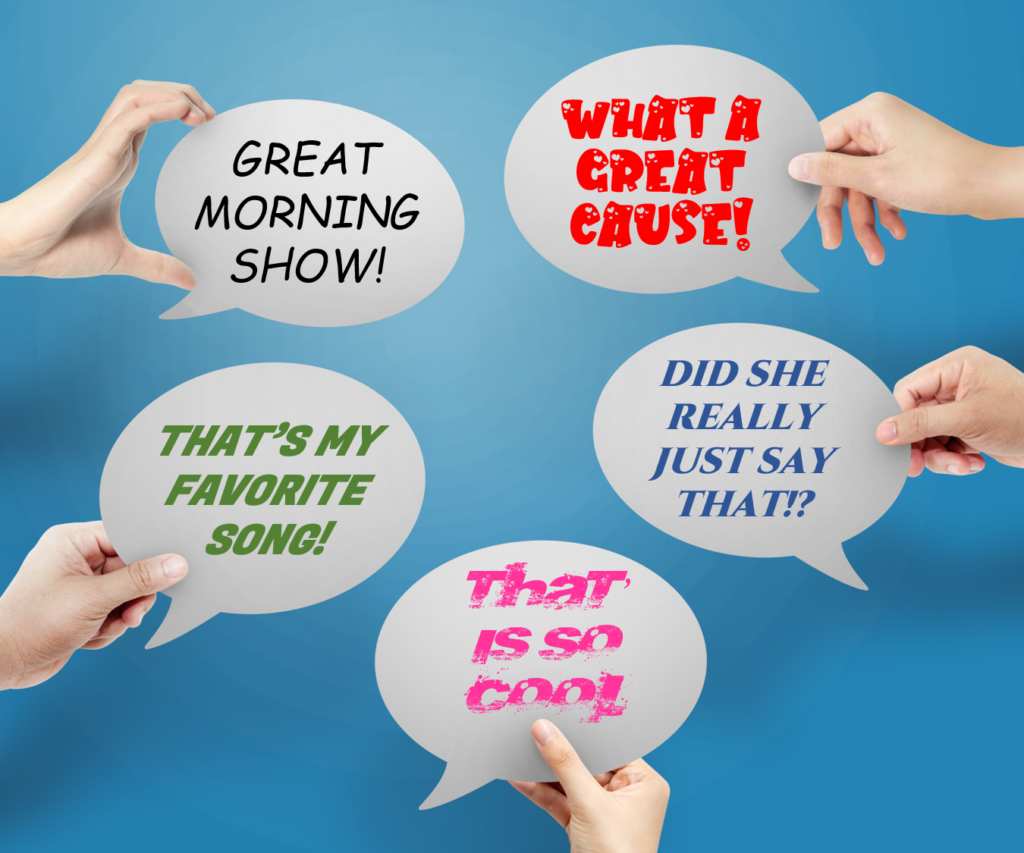
Techsurvey stakeholders and readers of this blog know how much I value buzz – more conventionally referred to by marketers as “word-of-mouth.”
Whatever you call it, the idea is for consumers, customers, and yes, listeners to happily do the heavy lifting and talk about you with others in their network.
Since the inception of our Techsurvey in 2004-05, we have asked the standard Net Promoter question. In essence, it’s a buzz measurement – the degree to which your listeners readily recommend to folks in their various circles – family, friends, co-workers, and connections in their social communities. The NPS – Net Promoter Score – is a gauge of brands where respondents tell us the degree to which they’d recommend a radio station or personality to others.
The premise behind word-of-mouth – or WOM, to use another marketing acronym – is that an enthusiastic thumbs-up about a brand – a car, a restaurant, a gadget, or a radio station – from a trusted person carries more weight than traditional marketing campaigns.
What convinces people more effectively? Seeing a billboard for a radio station OR having a colleague or relative go out of their way to suggest you check it out?
So, how can radio stations best accelerate the spread of their brand’s WOM – whether it is centered around the music, personalities, events, or fundraisers?
That was the topic in a recent article in MediaPost by Ed Keller, CEO of Engagement Labs. Ed’s a truly bright researcher who has spent much time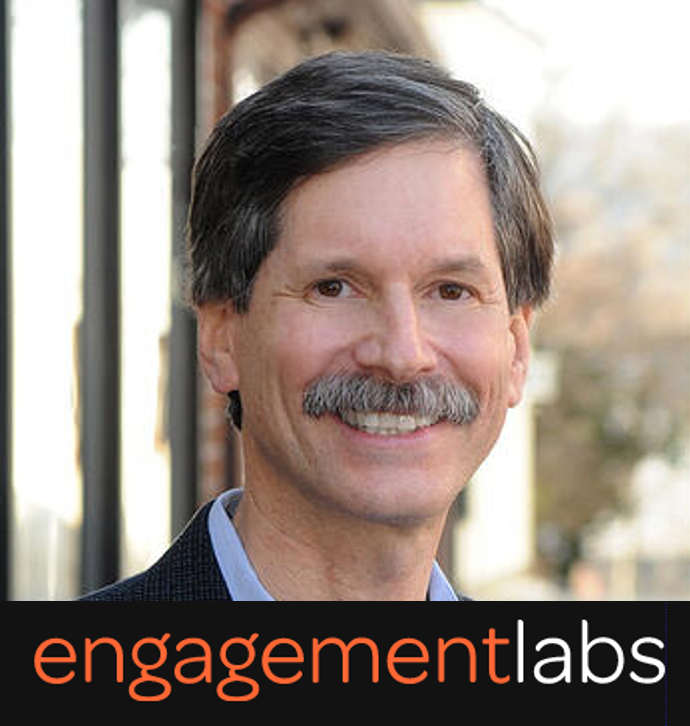 in the media ad measurement worlds. I’ve been fortunate enough to share the stage with Ed at media events. He’s a thoughtful expert on what propels WOM marketing.
in the media ad measurement worlds. I’ve been fortunate enough to share the stage with Ed at media events. He’s a thoughtful expert on what propels WOM marketing.
In “How to Become a Word of Mouth Maven,” Ed tells the unlikely story of Kotex, a brand that traditionally avoided actually talking about the product. When parent Kimberly-Clark made it OK to have the conversation about menstruation – more than a decade ago – WOM followed.
Ed notes that brand buzz can be driven by offline and online conversations, the latter mostly consisting of social media. But it turns out there are just a handful of product categories that do especially well on either side of the WOM spectrum. Here’s how it breaks down:
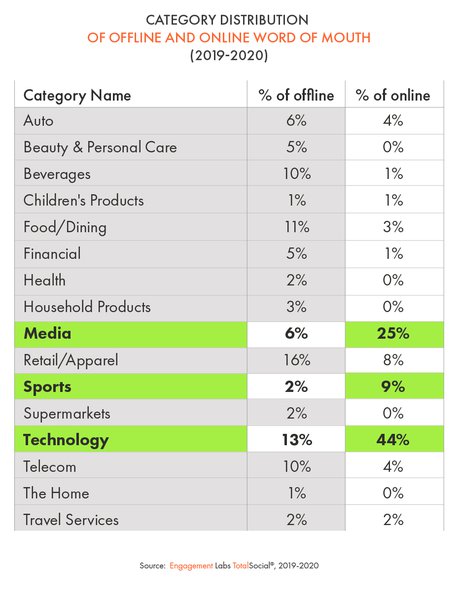
The green highlights show the three product categories that truly reap the benefits of online marketing – technology, media, and distantly, sports. That means that for radio and personality brands, you are often what people are buzzing about.
And that signals opportunity for radio in the social space – not just to post what is going on at the station or today’s concert announcement, but to be in the moment as an entertainment or information focused brand that connects with its listeners. In other words, activating the buzz.
If you know your station’s Net Promoter Score, you can determine if you’re a good candidate for a tactical WOM effort. Buzzworthy radio stations and personalities can then strategize how to harness the power of buzz with social posting activity via photos, videos, consumer-generated marketing, and other engagement tools. We have long talked about “pinballing” at Jacobs Media – bouncing listeners back and forth between social assets and the station itself. And fueled by buzz, stations can plan and plot those efforts that maximize WOM.
In addition to increased buzz, many radio formats in general, and stations specifically, can benefit from social acknowledgment – that is, making it a policy to respond to every listener rather than doing it every once in a while. That reciprocity can pay off in not just good will, but in word-of-mouth. Our Techsurvey research shows that approximately a third of listeners say they listen more to stations that engage with them socially. (Your “mileage may vary,” depending on your format, your core audience, your brand essence, and the strength and popularity of your personalities.)

Word-of-mouth is a great marketing tool – but a tricky one to harness. As the Engagement Lab data shows, most brands simply aren’t part of the social media conversation. That includes cars, restaurants, beverages, health products, financial firms, and household brands. People care about all these categories, of course, but they rarely show up in online postings.
But media brands – yes, radio stations – are the #2 buzz category, just behind technology. The essential foundation for higher level social interaction is already in place. Stations need to do a more strategic job of nurturing audience relationships socially in order to reap the benefits.
That means less “random acts of social,” and more purposeful posting and acknowledgment. Some radio broadcasters have a pro on staff who can help guide this activity, but most do not. Outside help and a higher sense of social media mindfulness can lay the groundwork for consistently generating buzz.
In an environment where most stations are hard-pressed to dig up marketing dollars – especially at this crucial time when life as we know it is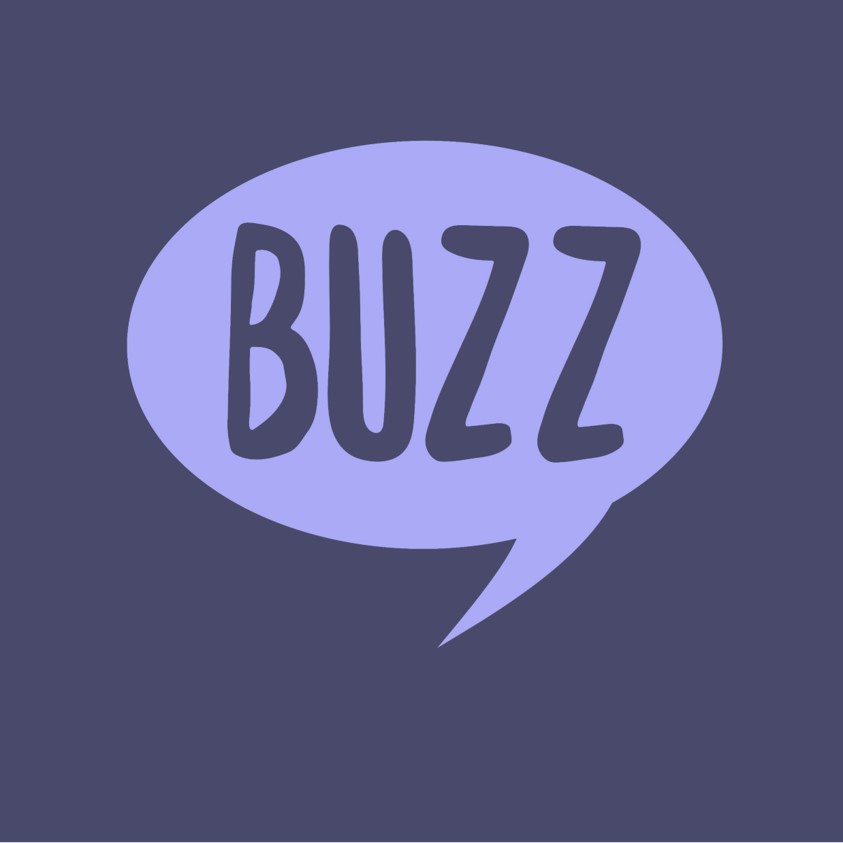 rebounding – a savvy social strategy can create an environment where buzz blossoms.
rebounding – a savvy social strategy can create an environment where buzz blossoms.
We talk a great deal about tapping into the emotions of the audience when they listen to your station or show – companionship, connection, mood elevation, escape. These are all feelings strong radio stations and their personalities elicit – especially when there is something going on locally and/or in their lives.
2020 was the most emotional year ever – a chance for radio to embrace the sadness and shock experienced by its audience. But this year is increasingly about being in the “joy moment” – celebrating life, renewal, and reunion with your listeners and their friends, family members, and co-workers. But also with their favorite bands, comedians, performers, and yes, radio personalities.
Appointment setting has become something of an art form for radio programmers. But often, it is a mechanical, scheduling process.
Building word-of-mouth is a more challenging task. It requires much thought, brainstorming, and planning – but it can be done. Oftentimes, it is fueled by giving listeners a seat at the table – letting them participate.
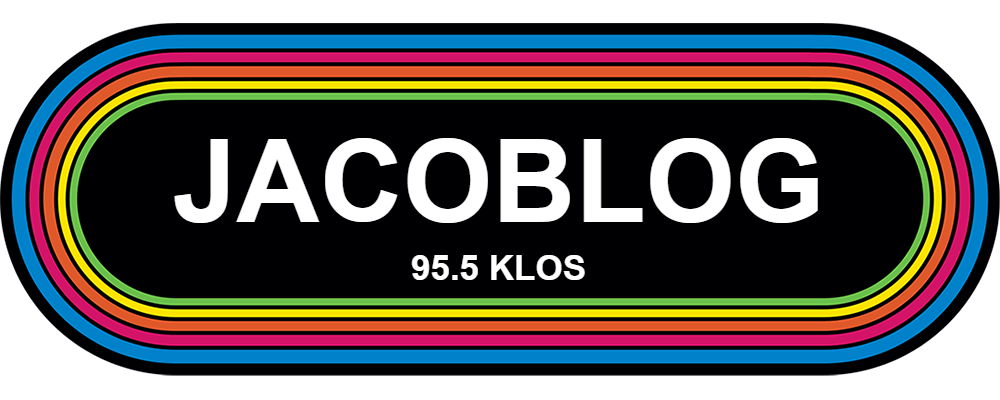 One of the best examples of this I’ve seen in a few years is KLOS’s “create your own logo.” Yes, it helps to have an iconic logo the entire market can visualize in their heads. But the secret sauce is in letting listeners create – and then share.
One of the best examples of this I’ve seen in a few years is KLOS’s “create your own logo.” Yes, it helps to have an iconic logo the entire market can visualize in their heads. But the secret sauce is in letting listeners create – and then share.
Ed Keller would tell you that being a well-branded station with personalities that matters is the fabric of buzz.
Is it a concert, a charity radiothon, a morning show stunt, a local sports team, a scandal, or a good deed?
Figure that out and you’ll identify what’s buzzworthy – right now today.
- What To Do If Your Radio Station Goes Through A Midlife Crisis - April 25, 2025
- A 2020 Lesson?It Could All Be Gone In A Flash - April 24, 2025
- How AI Can Give Radio Personalities More…PERSONALITY - April 23, 2025




We used to prioritize WOM, except we called it “Water-Cooler talk”…and would include WCT as part of an intangible indicator re: morning show measurables. Certainly when Howard Stern and other memorable, legendary morning shows were on AM/FM…..that was a much bigger deal….but in today’s environment, it’s no less important.
And while drive time radio may not be enthralling for all those commuters – assuming enough people are driving to & from work – like it did decades ago, it still can whoop up some buzznow and again. Programmers have to lean into these moments, identify them, and exploit them whenever possible. Thank to social, any good idea blog up with the right amount of planning (andd a little luck).
This seems obvious, but the best way to create a buzz is to do things that people find worth talking about and promoting.
“wow, I can win concert tickets before I can buy them on Eagle 101?”, “did you know that you can hear the same songs, same DJs and the same imaging on Rock 98 as on every rock station that company owns, along with 16 minutes of commercials every hour?”, “can you believe that every DJ on Lazer 105 gets two local references emailed to them/uploaded to their portal to mention when they record their show to make it sound like they live here?” are probably not good candidates for buzz.
Buzz costs money – you need to pay for people with the creativity to develop buzzworthy bits and events and for people with the talent to pull them off, so radio isn’t really in the the buzz business anymore. Radio execs would probably say if you can’t directly monetize something, its not worth doing, much less paying extra for.
It continues to amaze me how many good ideas you present in this blog that no one ever bothers to try on one station in one cluster. You must feel like the kid in class who always knows the answer, constantly raises their hand and never gets called on.
Bob, kind of you to think I have the answers. I do not. But I see an industry that has the potential to be more meaningful, profitable, and more competitive than it is today. We have all worked hard – in some cases, for decades – to build radio up. I hate to see much of that potential going unrealized. Thanks for the passion, as always.